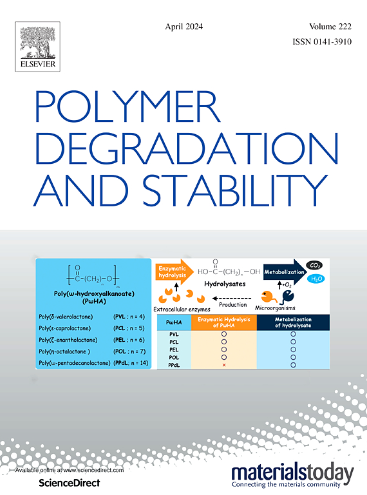电子束辐射和退火对3d打印pla基材料结晶度和拉伸性能的影响
IF 7.4
2区 化学
Q1 POLYMER SCIENCE
引用次数: 0
摘要
本文报道了电子束辐照对3d打印pla基材料的拉伸性能和结晶度的影响。监测关键拉伸性能随剂量变化的变化,证实了辐照的有害影响,在75 kGy的辐照后,抗拉强度和最终位移的典型损失约为50%。特别注意的是,在3d打印、辐照和优化条件下退火后,通过量热法和x射线衍射分析的样品中,晶体域的性质和结晶度χ。辐照样品的χ值最初从19%增加到24%,在100 kGy时又恢复到19%,然后在300 kGy时衰减更强。在此剂量范围内,相同样品的最大结晶量要高得多(χ> 60%)。因此,可以在辐照后调整结晶度,从而可能产生有益的影响,以减轻辐照的不良影响。对于在75 kGy辐照下拉伸强度和极限位移损失50 - 60%的样品,在60℃下进行软退火可以恢复辐照造成的部分机械损伤,拉伸强度提高20%,极限位移提高50%。这一显著的结果可以通过考虑对领带链演变的特殊敏感性来解释。虽然辐射下的链断裂在封闭的晶体区域是有效的和机械影响的,但化学结晶被认为是由于链断裂造成的损伤部分愈合而发生的。本文章由计算机程序翻译,如有差异,请以英文原文为准。
Effects of electron beam radiation and annealing on the crystallinity and tensile properties of a 3D-printed PLA-based material
This article reports on the influence of electron beam irradiation on the tensile properties and crystallinity of 3D-printed PLA-based materials. Monitoring the evolution of key tensile properties as a function of dose confirmed the detrimental effects of irradiation with a typical loss of about 50 % of tensile strength and ultimate displacement after a 75 kGy treatment. Particular attention was paid on the nature of crystalline domains and degree of crystallinity χ in samples analyzed by calorimetry and X-ray diffractometry, as obtained after 3D-printing, after irradiation and after annealing in optimized conditions. The χ value in irradiated samples was shown to initially increase from 19 to 24 % and return to 19 % at 100 kGy before a stronger decay at 300 kGy. The maximum crystallization capacity of the same samples was much higher (χ>60 %) within this dose range. Crystallinity can therefore be adjusted after irradiation with possible beneficial effects to mitigate the undesired impact of irradiation. For samples irradiated at 75 kGy with a loss of 50–60 % on tensile strength and ultimate displacement, part of the mechanical damage due to irradiation was recovered by soft annealing at 60 °C, increasing the tensile strength by 20 % and ultimate displacement by 50 %. This remarkable result can be interpreted by considering the particular sensitivity to the evolution of tie chains. While chain scission under radiation is effective and mechanically impactful in domains closed to crystallites, chemi-crystallization is believed to occur with partial healing of the damages due to chain scission.
求助全文
通过发布文献求助,成功后即可免费获取论文全文。
去求助
来源期刊

Polymer Degradation and Stability
化学-高分子科学
CiteScore
10.10
自引率
10.20%
发文量
325
审稿时长
23 days
期刊介绍:
Polymer Degradation and Stability deals with the degradation reactions and their control which are a major preoccupation of practitioners of the many and diverse aspects of modern polymer technology.
Deteriorative reactions occur during processing, when polymers are subjected to heat, oxygen and mechanical stress, and during the useful life of the materials when oxygen and sunlight are the most important degradative agencies. In more specialised applications, degradation may be induced by high energy radiation, ozone, atmospheric pollutants, mechanical stress, biological action, hydrolysis and many other influences. The mechanisms of these reactions and stabilisation processes must be understood if the technology and application of polymers are to continue to advance. The reporting of investigations of this kind is therefore a major function of this journal.
However there are also new developments in polymer technology in which degradation processes find positive applications. For example, photodegradable plastics are now available, the recycling of polymeric products will become increasingly important, degradation and combustion studies are involved in the definition of the fire hazards which are associated with polymeric materials and the microelectronics industry is vitally dependent upon polymer degradation in the manufacture of its circuitry. Polymer properties may also be improved by processes like curing and grafting, the chemistry of which can be closely related to that which causes physical deterioration in other circumstances.
 求助内容:
求助内容: 应助结果提醒方式:
应助结果提醒方式:


